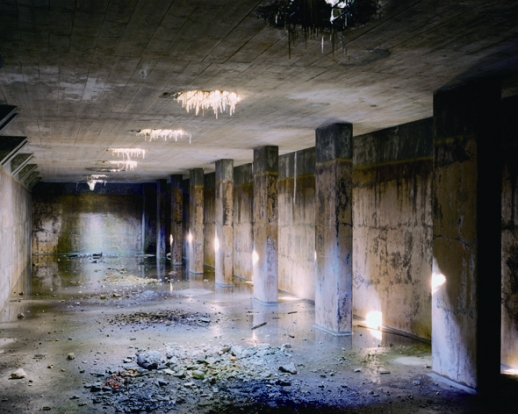The Scars of History
At first sight, Garbasz’s subdued landscape and interior studies are conspicuous for the absence of people and the sense of loneliness that permeates them. It is only when you read the accompanying texts describing concrete bunkbeds, beatings, hunger, lice and lack of bread that you realise why; the pictures illustrate the backdrop against which her mother experienced the Holocaust in three concentration camps, the loss of her parents and resettlement in a foreign land.
Yishay Garbasz took the images over a year on a journey that was both geographical and emotional. After finding out at eighteen that her mother was a Holocaust survivor, she realised she was still carrying unspoken trauma around with her, and had passed it on to her. Aware of the weight of the emotional ‘gap’ that she had inherited, Garbasz decided to retrace her footsteps to help begin the process of healing, using her own typewritten account of her experiences to guide her and to complement her photographs.
Mention the Holocaust and the first images that come into your head are only grainy black-and-white shots taken after the event; the liberation, the survivors, the empty camps. There is precious little visual record of the Holocaust camps during the war; we are left with our imaginations and damaged film. In our modern culture that demands photographs as evidence that something happened, the urge to find a way to document it has resulted in a wealth of art seeking to explain or deal with it. For Garbasz, it was about piecing together her mother’s life so that she could accept it and move on from the hurt, closing the gaps in her memory by bringing the past back. She chose to use a cumbersome large-format camera, she says, because it forced her to slow down and to absorb and concentrate on the atmosphere of where she was. The images reverberate with memories as a result of this quiet reverence.

There are the typical images of dank cellars, rusty soap dishes, filthy latrines and desolate fields circled with barbed wire, all of which evoke the kind of cold terror one associates with the Holocaust. But there are also landscapes with lush green grass, staircases diffused with soft golden light, an empty hall with a Palestinian flag. The most mundane image is a nondescript modern redbrick building with a fluorescent ‘MULTI VIDEO’ sign outside. These cheerful facades belie the horror that took place years before. But where grass grows and walls are painted over, raw emotions still pulse. The interplay between the daughter’s images and the mother’s words reminds one how that mere space becomes “place” when it is provided with a context or explanation. Here, an innocuous-looking green field becomes the place of rest for the grandparents’ ashes, the glimpses of Palestine, the fear settling in an unknown land, a grey room where a guard struck her mother against the head.
Garbasz writes that she is not sure how much the photographs have helped the healing process, and regrets that her mother never lived to see the final book. But by distilling the mass horror down to a singular pain shared between a mother and child, and locating it in the contemporary landscape, Garbasz reminds us how deep history’s scars lie in our modern geography, and how every individual leaves their own unique emotional trajectory in all the places they have been.
Sophie Knight
Sophie Knight



